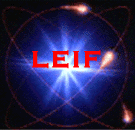 |
|||||||||||
|
|
|||||||||||
|
|
|||||||||||
|
|
|||||||||||
 |
|||||
 |
|||||
 |
|||||
 |
Results I Desired detectors II & III Detectors in use |
LEIF - Low-energy ion beam facilities Project 4: common tools and multi-coincidence detectors UBI (University of Bielefeld) As discussed during the Kick-off meeting in Grenoble we prepared a questionnaire to start the process of information transfer concerning detector systems.
----------------------------------------------------------------------------------------------- The questionnaire consists of 2 parts. The 1st part is aimed at a hypothetical detector you would like to have in
future experiments. Please be realistic with your demand. For example, we know of course that everyone would like to have effiency 1. The 2nd part should lead to a stock-taking of the systems currently in use.
I. Desired new detector system 1.1. What kind of events do you want to detect? (Please specify type and energy, e.g. proton 1-3 keV)
1.2. What kind of information should be derived? (Please specify the required resolution.) o time: o position:
o energy: o others (please specify) 1.3. Which minimum efficiency is necessary to make the experiment feasible? 1.4. Which dead time is tolerable?
- dead time of detector: - dead time of electronic readout: 1.5. Is it necessary to detect multiple hits? o yes
o no If you want to detect multiple hits, please specify the: - maximum number of coincident events
- typical time difference between events 1.6. How critical is the - long term stability (e.g. gain stability)?
- life time of the detector
II. Detectors in use 2.1. What kind of detector(s) do you use now? company/ type
o (a) Ionization detectors o (b) Scintillation detectors
o (c) Photomultipliers o (d) Channeltrons o (e) Micro-channel plates
o (f) Micro-sphere plates o (g) Semiconductor detectors o (h) others (please specify)
2.2. Please give details concerning the general characteristics of the detecor(s) you use:
- type(s) (see above) Detector ( ) Detector ( ) Detector ( ) - detected particle
- response time - resolution time: position:
energy: other: - efficiency - dead time
- multi-hit capability o yes o no if yes: number of coincident events
- long term stability - life time of the detector - estimated costs
without electronics: with readout electronics:
2.3. If you have information about some interesting literature or links concerning detectors, please name: 2.4. Have you heard of any interesting detector design that could be of interest for the LEIF network? Please
give reference (and specify if possible)
3. Since the experience shows that many detectors used in this field are based on micro-channel plates and micro-sphere plates the next section deals with this type of detectors in your present experiment. 3.1. How large is the diameter of the sensitive area? 3.2. Which type of anode do you use? o discrete
o (multi-)segment -> number of segments: o analog
o Backgammon o resistive anode
o delay-line o others (please specify) 3.3. What is the typical: - position resolution?
- time resolution? - efficieny? - deadtime? 3.4. What kind of readout system do you use?
3.5. Would an evaluation of electronic readout systems be of interest for you?
Which other points are of interest? If you know any additional interesting references please name them:
|
| [LEIF at Bielefeld] [Project 4: Detectors] [Our group] [LEIF-Links] |